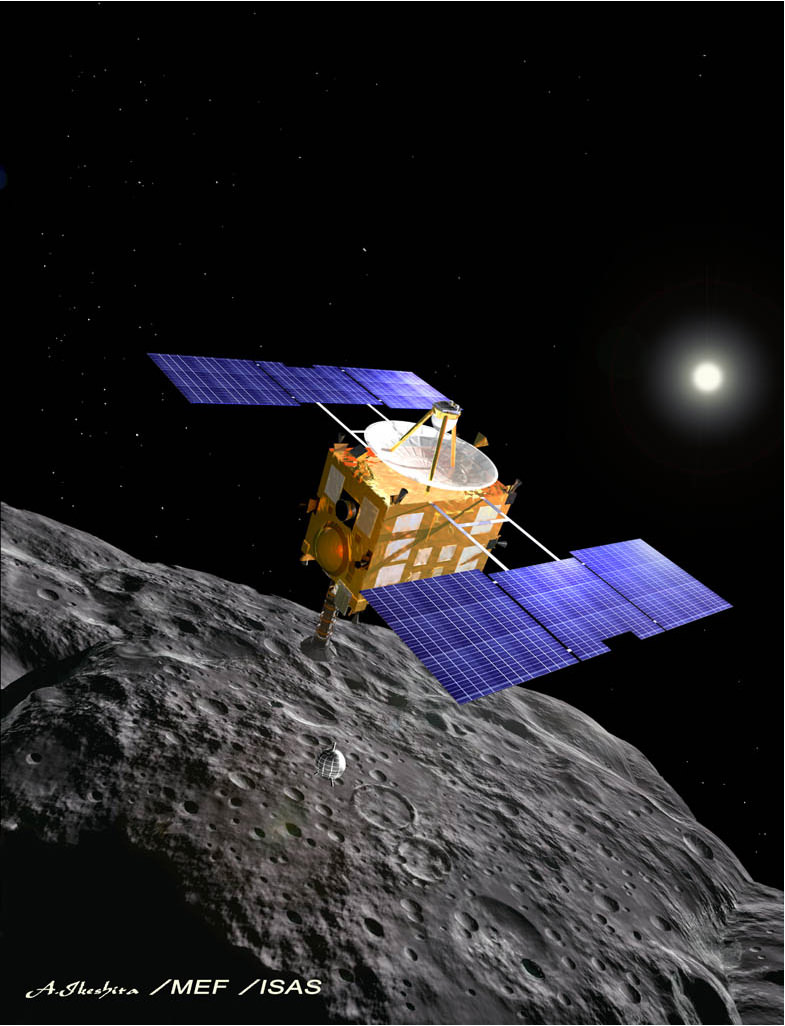[/caption]
As we reported last week, it seemed as if the Hayabusa asteroid explorer mission was dealt a fatal blow when the third of its four ion engines failed. But the Japanese Aerospace Exploration Agency (JAXA) announced yesterday that it may have come up with a solution to that problem to get Hayabusa back home by using components from two different inoperable thrusters in combination.
The Hayabusa mission has been rather plagued with problems throughout the entire mission. Its goal was to land on the asteroid Itokawa and return a sample to the Earth. It orbited the asteroid for three months in late 2005, and took near-infrared and X-ray spectral data. The landing, unfortunately, may or may not have gathered up a sample of the asteroid – though the container that the sample was supposed to go into may contain dust kicked up by the landing.
After taking off from the asteroid, communication was temporarily lost with the craft. Communication was re-established with the craft, but the ion thrusters that propel it began to have problems, and as we reported last week, 3 of the 4 thrusters on Hayabusa were no longer operational. Thruster D, which has been the sole source of propulsion for the craft since February 2009, gave out due to a voltage spike. The remaining thruster, C, was shut down to avoid damage. Things were starting to look pretty grim for a mission that has overcome a lot of problems so far.
In an announcement made by JAXA yesterday, a solution has been proposed to use part of two different thrusters in combination to propel the craft. Ion engines work ionizing a neutral gas – in Hayabusa’s case, xenon – and forcing them out of an electrified grid on the back of the craft. When this is done, though, there is a negative charge imbalance in the craft which would attract the ions right back into the engines. To compensate, a neutralizer ejects electrons into the ionized gas that has been released, so that they don’t come back into the craft and the charge of the craft remains neutral.
To fix the current problem, the JAXA engineers have proposed using the ion propellant from thruster B and the neutralizer from thruster A, effectively combining them into one complete thruster. Thruster A was deemed “unstable” after launch, and remains unused.
Thruster C will remain shut off, and only be used in case of failure of this rigged-up system. Its neutralizer is operating poorly, and given that the cause of failure for thrusters B and D was due to a neutrializer problem, the mission engineers want to be cautious.
Combining the engines will consume twice as much fuel and power as they would consume alone, but Hayabusa apparently has plenty of both in spades. 5 kg of fuel will be required to gain 200 meters per second acceleration over 2000 hours, but Hayabusa still has 20 kilograms of fuel in reserve. This system wasn’t tested on the ground, but apparently has worked in space for over one week (180 hours).
This thrusting combination will continue to propel the craft (barring further problems) until March 2010. If any other problems crop up, though, the team will have to delay the return of Hayabusa until 2013. If you want to see a cool – though somewhat cheesy – video of the Hayabusa mission so far, there’s a 30 minute one available on the mission site here.
Source: JAXA, The Planetary Society Blog


This is nothing short of heroic – how they keep coming up with solutions and just do not say quit.
Indeed, the ingenuity of man…
> to gain 200 meters per second acceleration over
> 2000 hours
Am I reading this right? This ion engine doesn’t just accelerate the rocket, it is designed to cause a steady increase in the rate of acceleration over a period of 2000 hours?
What a clever idea! Let’s hope this works and that Hayabusa makes it back.
I hope there’s something in the sample container.
Micah:
I don’t think you are reading it quite right. To my knowledge, the rate of acceleration is basically constant over that time period. In other words it takes 2000 hours to get up to the speed of 200m/sec.
Ion thrusters are like a very weak but very efficient rocket engine. Good if you have a long ways to go and aren’t in a hurry.
That’s exactly right, universe_adam. Ion engines don’t accelerate quickly at all, but are very, very efficient over long periods of time. We have a short article on them in the Guide to Space, http://www.universetoday.com/guide-to-space/spaceflight/ion-engine/
~Nick
Thanks universe_adam and Nick! You’re right, I missed the units that quote, m/s. I think it was the phrase of “200 meters per second acceleration” that flummoxed me.